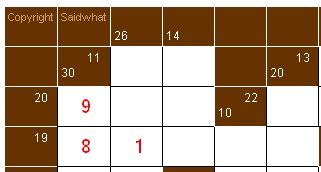
|
Kakuro is a popular game similar to sudoku in some ways. But is also suitably different. The key question: "How do you play Kakuro?", well here are the rules of kakuro.
The answer:
The kakuro grid, unlike in sudoku, can be of any size. It has rows and columns, and dark cells like in a crossword. And, just like in a crossword, some of the dark cells will contain numbers. Some cells will contain two numbers.
However, in a crossword the numbers reference clues. In a kakuro, the numbers are all you get! They denote the total of the digits in the row or column referenced by the number.
Within each collection of cells - called a run - any of the numbers 1 to 9 may be used but, like sudoku, each number may only be used once.
Let's have an example to explain this concept more clearly:

In the image above, which shows a section of a kakuro puzzle, you will see the numbers '26' and '14' in the top row. Look at the 14. This means that the total of the three cells underneath must sum to 14. Therefore 9, 4, 1 could be the answer, or perhaps 7, 4, 3 and so on...
So, how do you work out the actual combination? Well, this is done through elimination and cross-referencing. For instance, as you work out the answers for other kakuro clues, this will naturally limit the valid combinations, and hence the answer for this particular run.
Note the second cell in row two - it contains two numbers, 30 and 11. The 30 refers to the vertical run underneath the number 30 and the 11 refers to the two cells to the right, horizontally, of the number 11.
Kakuro Solving Strategy Hints and Tips >>
Quick Links to other games, puzzles and quiz games for you at Saidwhat:
Sudoku | Sudoku CD | Kakuro | Celebrity Hangman | Quotes Quiz |